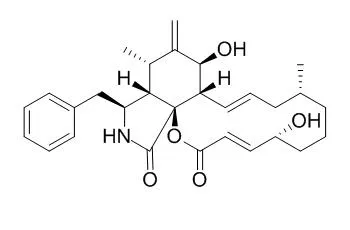| In vitro: |
| Oncotarget. 2017 Jul 31;8(41):70496-70507. | | Cytochalasin B-induced membrane vesicles convey angiogenic activity of parental cells.[Pubmed: 29050297 ] | Naturally occurring extracellular vesicles (EVs) play essential roles in intracellular communication and delivery of bioactive molecules.
Therefore it has been suggested that EVs could be used for delivery of therapeutics. However, to date the therapeutic application of EVs has been limited by number of factors, including limited yield and full understanding of their biological activities.
METHODS AND RESULTS:
To address these issues, we analyzed the morphology, molecular composition, fusion capacity and biological activity of Cytochalasin B-induced membrane vesicles (CIMVs). The size of these vesicles was comparable to that of naturally occurring EVs. In addition, we have shown that CIMVs from human SH-SY5Y cells contain elevated levels of VEGF as compared to the parental cells, and stimulate angiogenesis in vitro and in vivo. | | Biocontrol Science & Technology, 2014, 24(1):53-64. | | Effect of strain and cultural conditions on the production of cytochalasin B by the potential mycoherbicide Pyrenophora semeniperda (Pleosporaceae, Pleosporales).[Reference: WebLink] | The seed pathogen Pyrenophora semeniperda has demonstrated potential as a mycoherbicidal biocontrol for eliminating persistent seed banks of annual bromes on western North American rangelands. This pathogen exhibits variation in virulence that is related to mycelial growth rate, but direct laboratory tests of virulence on seeds often have low repeatability.
METHODS AND RESULTS:
We developed a rapid and sensitive high pressure liquid chromatography method for quantification of the phytotoxin Cytochalasin B in complex mixtures in order to evaluate its use in virulence screening. All 10 strains tested produced large quantities of this metabolite in solid wheat seed culture, with production varying over a fourfold range (535–2256 mg kg−1). No Cytochalasin B was produced in liquid potato dextrose broth culture, showing that its synthesis is strongly dependent on cultural conditions. In a Bromus tectorum coleoptile bioassay, solid culture extracts showed mild toxicity similar to the Cytochalasin B standard at a concentration equivalent to 10−4 M Cytochalasin B (72–95% of control), whereas at 10−3 M equivalent, the extracts exhibited significantly higher toxicity (8–18% of control) than the Cytochalasin B standard (34% of control).
CONCLUSIONS:
This suggests the possible presence of other phytotoxic metabolites. Cytochalasin B production in solid wheat seed culture exhibited the predicted significant negative correlation with mycelial growth rate on potato dextrose agar, but the correlation was not very strong, possibly because Cytochalasin B production and growth rate were measured under different cultural conditions. |
|






 Cell. 2018 Jan 11;172(1-2):249-261.e12. doi: 10.1016/j.cell.2017.12.019.IF=36.216(2019)
Cell. 2018 Jan 11;172(1-2):249-261.e12. doi: 10.1016/j.cell.2017.12.019.IF=36.216(2019) Cell Metab. 2020 Mar 3;31(3):534-548.e5. doi: 10.1016/j.cmet.2020.01.002.IF=22.415(2019)
Cell Metab. 2020 Mar 3;31(3):534-548.e5. doi: 10.1016/j.cmet.2020.01.002.IF=22.415(2019) Mol Cell. 2017 Nov 16;68(4):673-685.e6. doi: 10.1016/j.molcel.2017.10.022.IF=14.548(2019)
Mol Cell. 2017 Nov 16;68(4):673-685.e6. doi: 10.1016/j.molcel.2017.10.022.IF=14.548(2019)